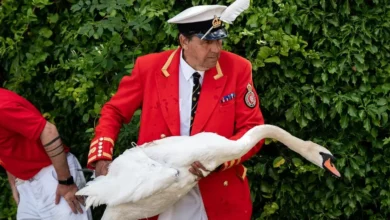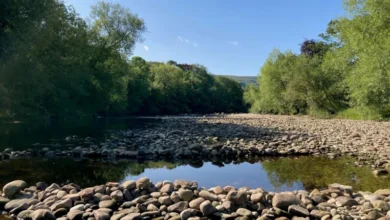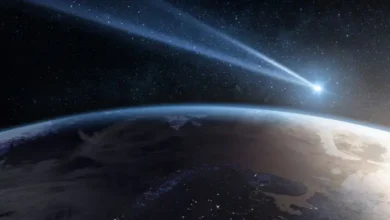Too hot for humpbacks: The race to protect Pacific whales

Move over Moby Dick. Big Mama, the first humpback whale to have returned to the North Pacific’s Salish Sea after decades of absence, is telling a new story about the global threat to whale populations.
By the start of the 20th Century, humpback whales had virtually vanished from the Salish Sea, a marginal body of the Pacific Ocean that spans the US-Canada border. The industrialised hunting of cetaceans had led global humpback populations to fall precipitously, and the North Pacific was no exception: fewer than 1,000 humpbacks were left in 1986 – down from 15 times that amount a hundred years before.
The tides turned for Salish Sea whales in 1997 when a single humpback showed up in British Columbia’s waters. Known as Big Mama, the fertile matriarch would go on to become the first regularly returning humpback spotted in the region in over nine decades.
Big Mama’s homecoming is not an isolated case. Thanks to global efforts – including an international ban on commercial whaling, as well as national interventions, such as the United States’ bipartisan Endangered Species Conservation Act – humpback whale populations have made a resounding global recovery. The International Union for the Conservation of Nature has even moved the species to a status of “Least Concern”, unlike some other large whales and most small coastal and freshwater cetaceans that remain endangered. Whether humpbacks can maintain this recovery, however, is another question.
Today, humpbacks are once again habitual summer visitors to the Salish Sea. The now 80-year-old Big Mama has given birth to seven calves since 2003, passing down generational knowledge of safe migratory patterns and where to find food. Nik Coutinho, who works for the whale-watching company Prince of Whales, claims to spot over 400 different humpbacks each year: “We call it whale soup,” he says.
But a new threat looms over this story of revival: climate change. As global temperatures rise, whales’ breeding and feeding patterns will be disrupted – leaving scientists scrambling to understand its knock-on effects.
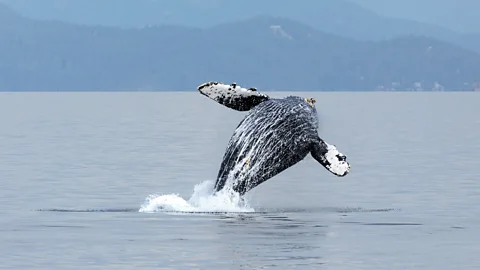
Breeding in a warming ocean
Humpback whales make one of the longest migrations of any mammal on the planet. One of the most closely watched routes spans 4,830km (3,000 miles), from Alaska to their breeding grounds in Hawaii.
The creatures, including matriarch Big Mama, give birth in sea temperatures between 21C and 28C (70F and 82F), which is ideal for calves who don’t have as much blubber as full-grown whales.
As the globe’s temperature patterns shift, however, scientists are warning that the whales may be forced off course. By the end of this century, rising greenhouse gas emissions will put several breeding grounds across the Earth’s hemispheres outside the humpback’s temperature tolerance, according to a 2022 study from the University of Hawaii in collaboration with the Pacific Whale Foundation.
“I was mortified seeing breeding ground after breeding ground turning red in our simulation,” says PhD candidate Hannah von Hammerstein, who worked on the research.
Hammerstein and her team concluded that, under a balanced “middle of the road” hypothetical scenario, which considers both the rate of climate change and efforts to reduce warming, about 37% of humpback breeding areas across the globe would have temperatures above the upper limit of 28C (82.4F) by the end of the century. If our fossil fuel emissions go unchecked, experts predict those figures will rise to 67% of humpback breeding grounds.
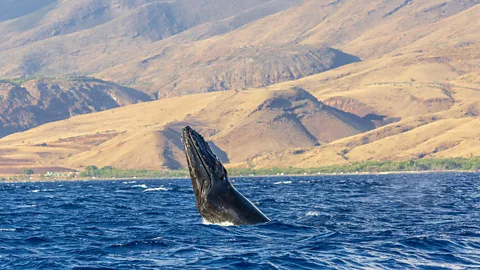
The temperature situation has also worsened since the study published in 2022, Hammerstein shared. “With current [global emissions] policies, the middle of the road scenario is now the best case,” she says. “We’re not doing too great.”
But there is a silver lining amid the scarlet figures. Between the middle of the road and the higher fossil-fueled development scenarios, there is a 30-percentage point difference in the viability of humpback whale breeding areas. This gap between the worst and best-case scenarios offers an incentive for conservationists, policymakers and researchers to mitigate greenhouse gas emissions, Hammerstein says.
The study’s authors also recommend establishing protected areas to take account of humpback whales’ shifting breeding grounds in the future. While some small marine species can physically adapt to temperature change and remain in their current geographic ranges, large long-lived mammals like humpbacks will likely not be able to adapt in time. Many marine mammals will likely react by moving poleward, to the cooler north.
I was mortified seeing breeding ground after breeding ground turning red – Hannah von Hammerstein
Some humpback whale population segments might discover new breeding areas further up north, provided these areas have suitable seafloors and safeguarding from predators, says Hammerstein. But protected areas for each humpback whale population segment, she adds, must be discerned on a case-by-case scenario.
No adjacent, alternative habitat exists for humpbacks that flock to Hawaii, a crucial and isolated wintering ground. This huge population segment will face suboptimal conditions, and in turn, decreased fitness, contends Hammerstein.
Cascading climate consequences
Nor is it just humpbacks’ breeding habits that will be impacted by a warming climate.
Their feeding grounds may also be at risk. Humpback whales eat krill, straining enormous volumes of ocean water via their baleen plates (the long, flexible hairs that grow out of their mouths in the place of teeth). In preparation for their migration, humpbacks consume several tonnes of krill a day. Yet krill populations have dropped by about 80% since the 1970s, due to a reduction of sea ice caused by rising sea temperatures.
Once food resources become limited, other risks ensue. One is the increased entanglement of humpback whales in fishing gear, as both humpbacks and humans go after the same remaining catch. Another is increased human-wildlife conflict, such as whales colliding with boats.
A third complication is disease. If a humpback whale is living in suboptimal conditions, it may cope, but will also be weakened. Scientists have seen evidence of whales appearing thinner and coated in parasites.

Scientists are now taking a bird’s eye view of these shifts in whales’ migration patterns and habitat use.
In Cape Cod Bay, off the coast of Massachusetts in the United States, one recent study has found that humpback whales’ peak occupancy was two weeks later in the season than 20 years prior, with no clear tie to spring thermal transition day, or the first day of spring. (The spring thermal transition day is the annual date when daily sea surface temperature first exceeds the yearly average of the region – and it can serve as a source of proxy data for climate change when the date is compared over time.)
While this study did not directly tie the migration shift to temperature, it is probably still related to climate change’s effect on the whales’ prey and conditions along humpbacks’ migration route, says Dr Laura Ganley, who has conducted large-scale aerial surveys for the Anderson Cabot Center for Ocean Life at the New England Aquarium.
Climate change’s effect on the spring thermal transition day impacts large species like whales but it also impacts organisms lower down their food chain, like chlorophyll and zooplankton. These “complex” links involve various players in the ecosystem: the specific habitat, the prey species and the species of interest, Ganley points out. Climate change is thus likely impacting humpback whales, even if the specific mechanisms and adaptations can vary by location and population segment.
“For a lot of species, the timing of movements and habitat use is shifting as a result of climate change,” says Ganley.
Another paper, conducted in the Gulf of St Lawrence, still in the Atlantic Ocean but up in Canada, also found a more direct connection between rising temperature and migration shift. By looking at the whales’ arrival day (not their day of maximum habitat use), researchers discovered that the humpbacks arrived earlier.
Climate-driven shifts in humpback whale migration timing can upset whales’ ability to find food resources and reproduce successfully, adversely impacting the health of populations.
Changing course
If the dates that whales show up near coasts are fluctuating, then citizens and policymakers need to change with them, says Ganley. Climate change begets collateral shocks on humpbacks through fluctuations in prey availability and distribution, posing challenges for conservation and management. For example, if protective measures – such as boating speed limits and fishing rules – are not adjusted to the returning whales’ earlier schedule, then the creatures may be more likely to collide with ships.
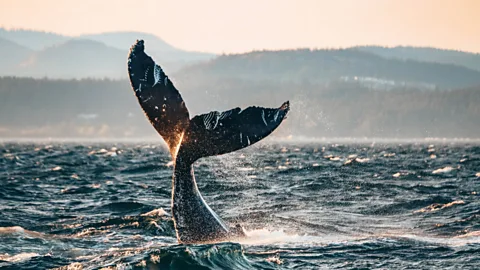
Whale watching itself may also pose risks to whales such as noise pollution and injury from boat propellers. To alleviate that impact in the Salish Sea, Prince of Whales claims it enforces an increased distance between the watchers and the whales, according to its website; the Victoria location has also built a more “quiet and fuel-efficient” catamaran while committing to offset a minimum of 110% of its carbon emissions.
Is ethical whale watching possible?
Whale watching is a $2b (£1.5b) global industry premised on providing encounters with these special creatures. But it’s crucial to whale-watch responsibly, to ensure these experiences do no harm. Here’s how you can make it happen.
Finding ways to support whales on their long journeys across the globe is especially vital considering their important relationships with other species, warns Ganley. The health of the ocean partially depends on the state of humpbacks. A bedrock species, humpback whales regulate the food chain through their “poop loop”: through consuming krill, humpbacks’ nutrient-rich faeces fertilises phytoplankton, a base of the whole marine food web.
Paying attention to where and when humpbacks travel is thus key, as their migration patterns will distribute nutrients throughout the waters of the world. And even if shifts are slow – perhaps two weeks in 20 years – they could still be highly consequential. Humpback’s migration routes, which have spanned eons, may look unrecognisable by the next century. “It’s like the frog in boiling water,” says Ganley.
Flicking her fluke off the coast of Canada, Big Mama symbolised a story of fragile hope for future generations as she breached in 1997. Now, scientists witness the new story humpbacks are telling as they move around the world.
